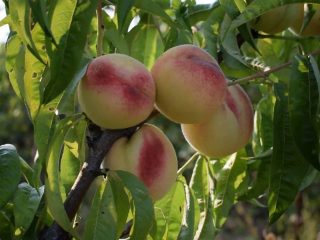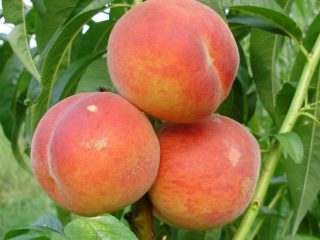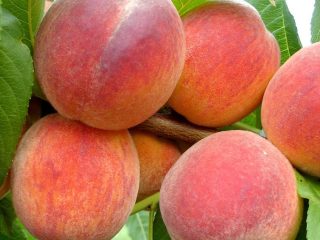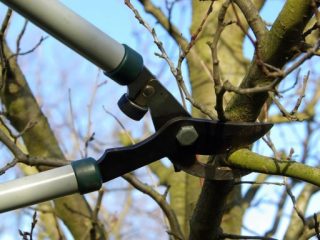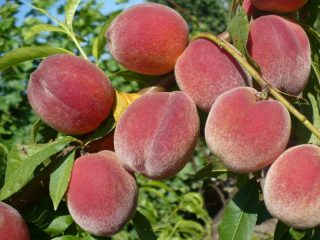Content
Early Kiev peach is classified as self-pollinating, early-ripening, early-ripening varieties. Among other varieties, this species is distinguished by high frost resistance and the ability to recover from frostbite.
History of variety selection
The Kiev Early peach variety is the result of painstaking breeding work by Soviet scientists, who were tasked with developing a new winter-hardy crop, adapted to the conditions of the Russian climate. Research on the development of the variety was carried out at the Institute of Horticulture of the UAAS under the leadership of A.P. Rodionova, I.A. Sheremeta, B.I. Shablovskaya.
The new species was obtained by crossing the varieties Grosse Mignon and Kashchenko 208 in 1939 and has since been considered the standard of frost resistance. In 1954, the Kiev Early peach was included in the State Register of Plant Varieties of Ukraine.
A derived subspecies of the Kievskiy ranniy variety, the Kievskiy late peach, is separately distinguished.
Description of the peach variety Kyiv early
Early Kiev peach is a medium-sized, high-yielding variety that forms a spherical compact crown of medium density. The height of the tree reaches 4 m. Young trees actively form new shoots; in adult plants, shoot formation stabilizes over time.
The leaves of the Kyiv early variety are dark green, oblong, tapered towards the end. The goblet-shaped flowers are bright pink.
Peach fruits are medium-sized - their weight varies from 80 to 100 g. The skin is thin and velvety to the touch, the flesh is juicy and tender. The description of the Kyiv Early variety emphasizes the unusually sweet taste of peaches.
The shape of the fruit is round, sometimes slightly flattened on the sides. The ventral suture is clearly defined. The color of the skin varies from pale light yellow to cream with a raspberry blush.
The stone is medium-sized, boat-shaped. It is not completely separated from the pulp.
Characteristics of the variety
Early Kiev peach is zoned for cultivation in the central zone of the Russian Federation, however, the high degree of resistance to frost allows this variety to be cultivated also in the northern regions of the country.
Drought resistance, frost resistance
The variety is considered a model of winter hardiness - it is able to safely overwinter at temperatures down to -26-27°C. Moreover, even in case of frostbite, the tree does not need to be uprooted, since it quickly recovers from the damage. As a rule, the next year the peach is ready to bear fruit.
The early Kiev peach does not tolerate drought well, which is confirmed by numerous reviews.
Does the variety need pollinators?
This species is a self-fertile variety, but it is hardly possible to obtain a bountiful harvest without pollinators. The following varieties of peaches are suitable for pollination:
- May Flower;
- Redhaven;
- Greensboro;
- Moretini's favorite;
- Velvety.
Productivity and fruiting
Peach flowering time occurs at the end of April - beginning of May. The variety blooms for 10-12 days. In mid-July the fruits begin to ripen.
Trees enter the fruiting period in the 3rd year after planting in open ground. The yield of the variety is quite high - from 30 to 45 kg of peaches are harvested from one plant with good care.
Area of application of fruits
The dense skin of the fruit ensures good transportability of the variety. Peaches can safely be transported over long distances and do not wrinkle in containers. The shelf life of fruits is on average 5-7 days.
Peaches are consumed fresh. They are also used to make jam and jam, and prepare compote. Part of the harvest is used to make candied fruits and marmalade.
Resistance to diseases and pests
Early Kiev peach is immune to most infectious diseases, but it often suffers from leaf curl. However, timely prevention of trees reduces the risk of infection to a minimum.
Among the pests dangerous to the variety, aphids and fruit moths are especially distinguished.
Advantages and disadvantages of the variety
The advantages of the variety include:
- high winter hardiness;
- ability to recover from frostbite;
- precociousness;
- high productivity;
- sweet taste of fruits;
- compactness of the crown, facilitating harvesting;
- resistance to powdery mildew and klyasterosporiosis.
The list of disadvantages of the variety is more modest:
- vulnerability to leaf curl;
- drought intolerance;
- poor separation of the stone from the pulp.
Rules for planting peach
Early Kiev peach develops well on almost all types of soil, but at the same time it is quite sensitive to the degree of illumination and wind.
Recommended timing
Seedlings do not have the same winter hardiness as mature trees and take root better in the spring. The optimal planting time is mid-April, but preparations for planting trees begin in the fall.
Choosing a suitable location
The only limitation on soil quality when choosing a place to plant this variety is the swampiness of the soil. Groundwater must flow at a depth of at least 1.5 m.
The illumination of the area is no less important. Peach trees should not lack sun.
Selection and preparation of planting material
When purchasing seedlings, you should pay attention to the presence of cracks, spots and dried areas on the trunk and shoots. In addition, healthy plants should have a well-developed root system - the minimum root length is 30 cm.
Landing algorithm
Before digging holes for planting peach trees, it is necessary to properly prepare the soil of the site. The soil is dug up and cleared of weed and dry leaves, after which they are moistened abundantly.
As a fertilizer to saturate the soil, a mixture is used, which includes the following components:
- potassium chloride – 100 g;
- humus – 12-15 kg;
- superphosphate – 150-200 g;
- ash – 300-400 g.
This amount is enough to fertilize 1 m2 land.
15-20 days after fertilizing the site, you can begin planting trees. The landing procedure is as follows:
- Planting holes are dug with parameters 40x40x40, while the top layer of soil is mixed with fertilizers, which can be peat or humus.
- The bottom of the hole is covered with drainage made of gravel or broken brick. The layer thickness should not exceed 10 cm.
- A peg with a diameter of 5 cm and a height of at least 1.5 m is driven into the middle of the hole.
- A mound of soil mixture is poured over the drainage, on which the seedling is placed. It must be carefully tied to the post.
- The roots of the plant are evenly distributed over the hill, after which they are sprinkled with earth, compacted and watered (20-30 liters of water will be enough).
- The planting procedure is completed by mulching with a mixture of peat and sawdust. The optimal layer of mulch is 5 cm.
Peach aftercare
Peach is considered a rather capricious crop, the care of which is quite painstaking, but this does not apply to the Kyiv variety. Mandatory conditions for the normal development of a tree are only regular watering and prevention against diseases.
Early Kiev peach is watered once every 7-10 days, with 20-40 liters of water used for each bush. Watering is especially important during fruit ripening.
Pruning trees is not necessary, but when the crown thickens, removing excess shoots helps provide the fruit with enough light.
The following are subject to removal:
- dried or frostbitten shoots;
- incorrectly growing, twisted branches;
- branches that shade the fruit too much.
More details about the features of the pruning procedure are described in the video:
In northern regions with harsh winters, peach trees are prepared for wintering. Preparatory measures include the following steps:
- The tree trunk circle is watered abundantly and mulched with a mixture of humus and sawdust.
- The upper branches and trunk are covered with lime and clay as protection against pests.
- After whitewashing, the trees are covered with spruce branches.
Diseases and pests, methods of control and prevention
The early Kiev peach variety is immune to most fungal diseases, but is vulnerable to leaf curl. Preventive measures include treating trees with industrially produced chemicals or homemade solutions.
The onset of the disease is indicated by coarsening of leaf blades, buds and young shoots. Subsequently, the leaves curl and turn red.
The photo below shows a Kyiv early peach affected by leaf curl.
As a preventive measure, peach is treated in the spring with Skor in a proportion of 2 ml per bucket of water. Treatment is carried out 2 times every 20 days.
If the disease has already affected the plants, they must be sprayed with a solution of Bordeaux mixture.
Conclusion
Early Kiev peach is well adapted to the Russian climate and is resistant to frost, which is why the variety is still popular among gardeners, despite competition from younger species. In addition, the variety has gained popularity due to its early fruiting and relative unpretentiousness.




